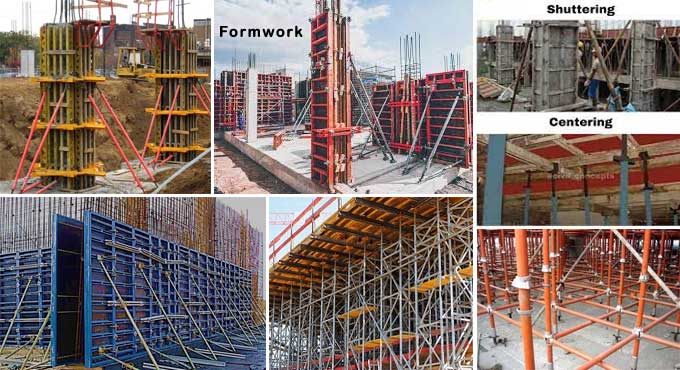NEWS | SOFTWARE | SHEET
The Definitive Guide to Formwork, Shuttering, Centering, Staging & Scaffolding
Temporary structures used during the construction process can be described in a variety of terms. There are many terms associated with formwork and scaffolding, including shuttering, centring, staging, and scaffolding.
Despite their similar appearances, the two have distinct purposes and functions. To ensure successful and safe building projects, this comprehensive guide will explain the differences between these terms, their roles in construction, and their significance.
What is the Importance of Temporary Structures in Construction?
Construction requires temporary buildings because they allow concrete to be poured and cured in a safe and regulated setting. Concrete would be unable to hold its own weight without temporary supports, making it impossible to achieve the appropriate final surface.
The Design and Construction of Temporary Structures
A temporary structure's design and construction is a complex process, involving a number of factors, such as the type of concrete that will be used, the size and shape of the structure, the weight of the concrete, and the environmental conditions. These factors all need to be carefully considered, including the type of concrete that will be used.
The Safety of Temporary Structures
There is a great deal of importance placed on the safety of temporary structures. There is a need to ensure that temporary structures are designed and constructed so that they can withstand the weight of the concrete and the forces of gravity. In order for them not to collapse, they must also be properly anchored so that they do not fall over.
What is Formwork in Construction?
Concrete elements such as walls, columns, beams, and slabs are formed using formwork, a temporary structure used to create their desired shape and structure. The cast-in-place supports the concrete during pouring and curing until it reaches a sufficient strength to stand on its own.
In addition to timber, plywood, steel, aluminium, and steel, there are a variety of materials that can be used in the construction of formwork. Complexity, budget constraints, and durability are all factors that influence the choice of material.
What is Shuttering in Construction?
Shuttering is a building industry word that describes the process of producing formwork. It entails putting together the framework and panels that will define the shape and proportions of the concrete part.
Shuttering can be done using either prefabricated panels or by building the structure on-site. The panels or structure are tightly fastened in order to keep the concrete in place and avoid leaking. The shuttering is removed once the concrete has cured, leaving a sturdy framework behind.
What is Centering in Construction?
Centering can be either referred to as falsework or temporary supports that are needed to support the weight of the formwork and the newly poured concrete, which are sometimes referred to as temporary supports. In the construction process, it helps keep the formwork sturdy and aligned during the process of building it.
Whenever there is extra support required for the formwork on arches, vaults, or other curved structures, centering is of vital importance. The most popular materials for centering are wooden props, steel supports, and scaffolding systems.
What is Staging in Construction?
Another term used in the construction industry is staging, which refers to a temporary platform or framework which is used to provide access and support to workers and materials during the construction process.
Typically, this type of platform is used in the masonry industry, plastering, painting, and other tasks where workers need a stable work platform at different heights in order to complete their work. Stages are usually constructed from wooden planks or metal platforms that are supported by scaffolding or other forms of structural support.
What is Scaffolding in Construction?
In the construction, maintenance, or repair field, scaffolding is a temporary structure that supports workers, tools, and materials during the course of the job. This structure consists of vertical and horizontal members, platforms, as well as various components that connect them together.
At different elevations of a building, scaffolding can be used to provide a safe working environment, allowing workers to gain access to hard-to-reach areas of the building. Furthermore, it contributes to the stability of the vehicle and the prevention of accidents. It is possible to construct scaffolds from steel, aluminium, or bamboo, depending on the requirements and regulations of the project.
To get more details, go through the following video tutorial.
Lecturer: Civil Engineer Deepak Kumar
Formwork, shuttering, centring, staging, and scaffolding are all integral parts of a construction project, but understanding their different roles and distinctions is essential to the success of a construction project. This is where shuttering and formwork come into play, because formwork refers to the structure that shapes the concrete, whereas shuttering refers to the process by which the formwork is assembled.
The purpose of centering is to provide additional support to the formwork, especially for structures that are curved or complex, while staging is intended to provide workers with a stable platform during specific tasks. In addition, scaffolding can be used throughout the construction process as a comprehensive support system for workers as well as materials.
Having a clear understanding of the difference between these terms and their functions is essential for construction professionals to ensure the successful completion of projects while focusing on safety and efficiency. For improving the quality of construction, ensuring structural integrity, and providing a safe working environment for the construction team, it is crucial to utilize formwork, shuttering, centering, staging, and scaffolding efficiently.


